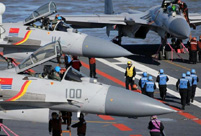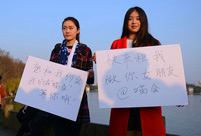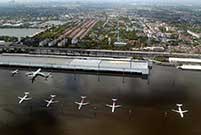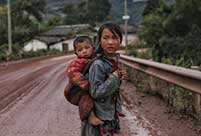

| A US Air Force B-52 (right) flies over Osan Air Base in Pyeongtaek, the Republic of Korea, Jan 10, 2016. [Photo/Agencies] |
The first two weeks of the New Year have seen new military developments in many parts of Asia.
Following the nuclear test by the Democratic People’s Republic of Korea on Jan 6, the United States flew a nuclear-capable B-52 bomber over the Korean Peninsula on Sunday. US allies also have been active, with the Republic of Korea considering more deployment of US "strategic assets" and Japan boosting its presence in the South China Sea.
Beijing responded that "hopefully, relevant countries will act cautiously and properly tackle the issue".
"As one country seeks its own security, it must consider the security interests of other countries as well as the peace and stability of the region," Foreign Ministry spokesman Hong Lei said on Wednesday.
Hong said that the current Korean Peninsula situation "is of great sensitivity" and that relevant countries hopefully will serve the big picture of ensuring regional peace and stability, cautiously and properly tackling the issue.
The purported hydrogen bomb test by the DPRK has sharpened the tension in East Asia. In her New Year’s address on Tuesday, ROK President Park Geun-hye said that deployment of an advanced US THAAD missile defense system to the ROK will be reviewed based on national security issues, considering the nuclear and missile threat from the DPRK, the Seoul-based Korea Herald reported. The US sent a B-52 bomber based in Guam on a flight over the ROK on Sunday.
ROK spokesman Kim Min-seok said on Monday that the US and ROK were continuously and closely discussing additional deployment of "strategic assets". Media in the ROK said that key high-end US military assets that could be deployed to the peninsula include a nuclear-powered submarine, F-22 stealth fighter jets and B-2 stealth bombers.
General Curtis Scaparrotti, commander of US Forces Korea, asked his troops and the ROK Army to maintain the highest level of readiness. The US has about 28,500 troops stationed in the ROK. The two countries usually have annual joint military exercises in February or March.
Wang Fan, vice-president of China Foreign Affairs University, said mounting military pressure on the peninsula won’t help address security issues, since the United States could use the occasion to form a military advantage in Northeast Asia. This in turn would increase tensions in the region by forcing other countries to react, Wang said.
He suggested talks between individual countries under the framework of the Six-Party Talks, such as talks between the Republic of Korea and the DPRK and talks between the United States and the DPRK. The Six-Party Talks, which collapsed in 2008, brought together China, the United States, Russia, Japan, the ROK and the DPRK.
"Fundamentally, there should be talks over the establishment of a multilateral security mechanism for the region, instead of individual alliances," Wang said.
The DPRK and ROK remain in a technical state of war after their 1950-53 conflict ended in a truce.
Meanwhile, the Supreme Court in the Philippines declared on Tuesday that a defense pact allowing the US to temporarily base warships and planes at local military sites is constitutional.
Renato Reyes Jr, secretary-general of Bagong Alyansang Makabayan, also known as Bayan, a group that opposes US military involvement in the Philippines, said that Tuesday was "another sad day for Philippine sovereignty".
"The decision will pave the way for the construction of new US military facilities in different parts of the country," he was quoted by the Manila Times as saying.
Additionally, Japan’s Defense Ministry and Self-Defense Forces have decided to allow the country’s P-3C patrol aircraft to stop at bases of countries facing the South China Sea when returning from anti-piracy activities off the coast of Somalia, according to the Yomiuri Shimbun newspaper, which quoted Japanese government sources.
The newspaper said the move will allow Japan to support US patrols around the islands in the South China Sea.
The Self-Defense Forces’ P-3C aircraft travel between Japan and Africa about every three months. Previously, the aircraft refueled at bases relatively far from the South China Sea, in countries including Singapore and Thailand. While their outward journeys remain the same, the P-3C aircraft, on their return trips, will give priority to bases around the South China Sea, such as those in Vietnam, the Philippines and Malaysia.
Japan is strengthening relations with nations that are contesting territorial rights with China in the area. In June, Japan conducted its first joint search-and-rescue drills with the Philippines, and in November it reached an agreement with Vietnam to hold the first Self-Defense Forces drills in Vietnam waters and to allow the SDF to dock at Cam Ranh Bay in Vietnam.
Shi Yinhong, a professor of international relations at Renmin University in Beijing, said the P-3C’s stopping at the new bases drives home the message that Japan has decided to boost its presence in the South China Sea. China should be prepared to respond to such provocations in the future, though its priority should still be maintaining peace and stability, Shi said.
Yang Bojiang, deputy director of the Institute of Japan Studies of the Chinese Academy of Social Sciences, said Japan must have racked its brains to come up with such a way to meddle in the South China Sea.
Letting Japanese aircraft take a detour on their return trips will not significantly increase Japan’s military spending. But by doing so, Japan will show its determination to strengthen its presence in the South China Sea, support the US pivot-to-Asia strategy and coordinate its maneuvers in the disputes over the Diaoyu Islands in the East China Sea, Yang said.
 Beautiful skiers wear shorts in snow
Beautiful skiers wear shorts in snow Getting close to the crew on China's aircraft carrier
Getting close to the crew on China's aircraft carrier Chinese stewardess celebrate test flight at Nansha Islands
Chinese stewardess celebrate test flight at Nansha Islands A beauty's dancing youth
A beauty's dancing youth "Rent me as your girlfriend!"
"Rent me as your girlfriend!" World's first 'underwater skyscraper'
World's first 'underwater skyscraper'  Top 10 weapons in the world in 2015
Top 10 weapons in the world in 2015 Are these the world’s scariest landing strips?
Are these the world’s scariest landing strips? In pics: Left behind children in China
In pics: Left behind children in China Top 20 hottest women in the world in 2014
Top 20 hottest women in the world in 2014 Top 10 hardest languages to learn
Top 10 hardest languages to learn 10 Chinese female stars with most beautiful faces
10 Chinese female stars with most beautiful faces China’s Top 10 Unique Bridges, Highways and Roads
China’s Top 10 Unique Bridges, Highways and Roads Doctor deceit
Doctor deceit Cash for trash
Cash for trash ‘AIDS village’ looks to the future after hundreds have died
‘AIDS village’ looks to the future after hundreds have died Foreigners having a hard time finding psychological help in China
Foreigners having a hard time finding psychological help in ChinaDay|Week